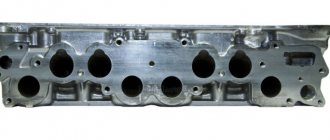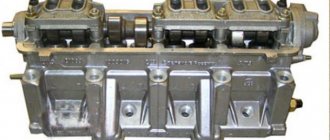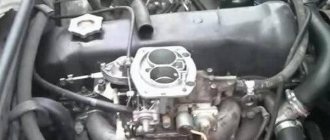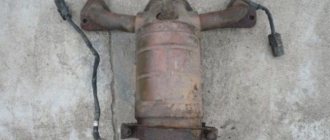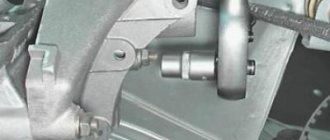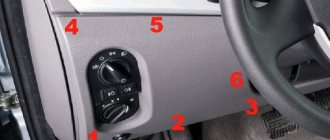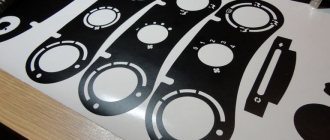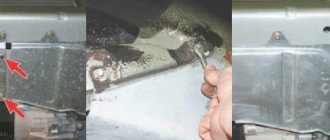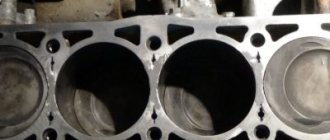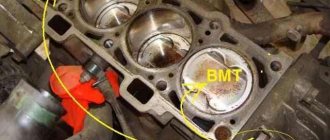A breakdown of the cylinder head gasket leads to such unpleasant consequences as engine overheating, poor operation of the stove, the appearance of exhaust gases from under the hood of the car, the appearance of an emulsion in the engine oil, the appearance of white smoke from the exhaust pipe and some others. If the above symptoms or one of them appear, you need to check the cylinder head gasket. There are several ways to do this. Next, we will look at why the cylinder head gasket breaks, what consequences this leads to, and what to do if this trouble happens to your car’s engine.
Signs that the cylinder head gasket has blown
The purpose of the cylinder head gasket is to ensure tightness and prevent gases from penetrating from the cylinders back up into the engine compartment, as well as mixing coolant, engine oil and fuel with each other. In a situation where the cylinder head gasket is punctured, the seal of the block is compromised. The following signs will tell the car owner about this:
Signs of a burnt cylinder head gasket
- Exhaust gases coming out from under the cylinder head . This is the simplest and most obvious sign. When the gasket burns out, it begins to let in exhaust gases that will escape into the engine compartment. This will be visible visually, as well as audibly - loud sounds will be heard from under the hood that are simply impossible not to notice. However, if the burnout is small, then you need to pay attention to other signs.
- Shot between cylinders .
External signs will resemble those that occur when the engine “troubles.” The fuel mixture from one cylinder is mixed with exhaust gases in the other. As a rule, in this case it is difficult to start the engine, but after warming up it continues to run steadily. To determine the breakdown, it is necessary to measure the compression of the cylinders. If the mentioned mixing occurs, the compression value in different cylinders will differ significantly. Emulsion from under the expansion tank cap - Exhaust gases entering the coolant . If the cylinder head gasket is punctured, a small amount of exhaust gases from the cylinder block body can enter the cooling system. In this case, it is enough to unscrew the radiator cap or expansion tank. If gases enter the system in large quantities, the seething will be very active. However, if there is little gas, then improvised means are used for diagnosis - plastic bags, balloons, condoms . We will discuss the diagnostic method in detail below.
- Antifreeze gets into one of the cylinders . As a rule, this occurs due to a rupture of the gasket in the place between the cooling jacket channel and the combustion chamber itself. This often results in the appearance of white smoke from the exhaust pipe, even in warm weather. And the antifreeze level in the tank drops. The more antifreeze gets into the cylinders, the more white steam will come out of the exhaust pipe.
- Oil leaking outwards from under the cylinder head .
These facts may also be signs of a burned out cylinder head gasket. That is, its outer shell ruptures. In this case, oil leaks can be seen in the area of the junction of the cylinder head and the cylinder head. However, their reasons may lie elsewhere. Foam in the expansion tank - Significant and rapid increase in engine temperature . This phenomenon occurs due to the fact that hot exhaust gases enter the cooling system, as a result of which it cannot cope with its tasks. In this case, in addition to replacing the gasket, it is also necessary to flush the cooling system. How to do this and by what means you can read separately.
- Mixing oil and antifreeze .
In this case, coolant may enter the engine compartment and mix with the oil. This has a very detrimental effect on the engine, since the properties of the oil are lost and the engine is forced to operate in unsuitable conditions, which leads to significant wear. This malfunction can be diagnosed by the presence of oily spots in the expansion tank of the cooling system. To do this, you need to open the oil filler plug and look at the inner surface of the cap. If there is an emulsion on its surface (also called “sour cream”, “mayonnaise”, etc.) of a reddish color, it means that antifreeze has mixed with oil. This is especially true when the car is not parked in a warm garage, but outside in winter. Similarly, you need to look for the presence of the mentioned emulsion on the oil level dipstick. Wet candles - Poor operation of the stove . The fact is that when the cylinder head gasket burns out, exhaust gases appear in the cooling “jacket”. As a result, the heat exchanger of the heater becomes airy, and accordingly, its operating efficiency decreases. Often, the temperature of the coolant jumps sharply.
- Increase in pressure in the radiator pipes . If the gasket is depressurized, exhaust gases will enter the cooling system through the pipes. Accordingly, they will become very hard to the touch; this can be checked simply by hand.
- The appearance of significant carbon deposits on the spark plugs . In addition, they can literally be wet due to the presence of antifreeze or moisture in the cylinders.
A clear sign of engine overheating is the presence of condensation on its surface. This is also an indirect sign of a burnt-out cylinder head gasket or a crack in the cylinder block. First of all, it is necessary to conduct computer diagnostics of the engine. The presence of errors will indicate the direction and possible additional faults. As a rule, these errors are associated with problems in the ignition system.
Antifreeze in the cylinder
Let's look again at mixing antifreeze and oil. As mentioned above, as a result of mixing them, an emulsion of a yellowish (most often) color is formed. If it appears, then simply replacing the cylinder head gasket will not be enough to repair. It is imperative to flush the system of this composition. Including pan and oil channels. And this may cost you additional costs, sometimes comparable to a major engine overhaul.
We have dealt with the symptoms that occur when the cylinder head gasket is broken. Next, let's move on to considering the reasons why its burnout can occur.
Reasons for gasket burnout
There are few reasons why a cylinder head gasket burns out, but with a new engine there is only one – overheating. Even a short time of engine operation at temperatures above normal can cause this malfunction. In this case, the gasket may burn out quite a bit, and inexperienced motorists will not notice the first symptoms that appear. With further operation, the burnout increases, and the symptoms become more pronounced. Due to the fact that many car owners turn to specialists not after overheating, but after some time of operation, when the malfunction becomes a clear fact, they do not connect the burnout of the gasket with the recent overheating and demand from motorists other explanations why the cylinder head gasket burned out.
If the volume of coolant is insufficient, you may not notice a slight overheating of the head, since the liquid, circulating in the system, manages to cool in the radiator, but does not have time to remove heat in the required amount. Instruments in a car show the temperature of the coolant, not the temperature of the engine parts. Thus, when operating a car with an insufficient level of antifreeze, you can burn the gasket without realizing that the cause was overheating.
Burnouts occur due to poor-quality gaskets, but this mostly applies to engines after repair. This happens extremely rarely on new cars. Even on repair engines, the cause of such a malfunction may be factors related to the quality of the repairs performed:
When filling the cooling system with liquid, it is important to remove all “air plugs”! Otherwise, you can “burn” the gasket the first time you start the engine.
Why does the cylinder head gasket break?
In most cases, the reason why problems arise with the cylinder head gasket is simple overheating . Because of it, the block cover may “lead”, and the plane along which the gasket adheres to two contacting surfaces will be disrupted. As a result, depressurization of the internal cavity occurs with all the ensuing consequences. It is mainly aluminum heads that change their geometry. Cast iron is not subject to such malfunctions; they are more likely to crack than to bend, and only in the most extreme cases.
Scheme for pulling cylinder head bolts on VAZ “classics”
Also, due to overheating, the gasket can heat up to temperatures at which it changes its geometry. Naturally, in this case depressurization will also occur. This is especially true for iron-asbestos gaskets.
Another reason is a violation of the bolt tightening torque . Both very large and small torque values have a detrimental effect. In the first case, the gasket may collapse, especially if it is made of low-quality materials. And in the second, exhaust gases pass out without obstructing them. In this case, gases together with atmospheric air will have a detrimental effect on the gasket material, gradually destroying it. Ideally, the bolts should be tightened using a dynamometer that shows the torque value; in addition, the sequence of their tightening should be observed. Help information about this can be found in the manual.
As a rule, the tightening sequence is to tighten the central bolts first, and then the rest diagonally. In this case, twisting occurs in stages. In particular, in VAZ cars of “classic” models, the torque step is 3 kgf. That is, all bolts in the specified sequence are tightened to 3 kgf, after that they are tightened to 6 kgf, and to 9...10 kgf.
According to statistics, in about 80% of cases when the gasket failed, the reason for this was incorrect tightening torques or non-compliance with its sequence (diagram).
And the most obvious reason is the low quality of the material from which the gasket is made. Everything is simple here. Try to buy products from trusted stores. When choosing, you must be guided by the “golden mean” rule. The gasket, of course, is inexpensive, so you shouldn’t overpay, nor should you buy downright cheap garbage. The main thing is that you are confident in the store where you are making a purchase.
It is also possible that the head gasket simply burned out due to wear and tear of the material , because everything has its own service life.
Examples of cylinder head gasket breakdown locations
Also, sometimes the reasons for the operation of the gasket are problems with disruption of the fuel combustion process (detonation, glow ignition). The cylinder head suffers greatly due to overheating. Cracks may appear in it, which will also lead to depressurization of the described systems. The head is usually made of aluminum. And when heated, it expands faster than steel bolts. Therefore, the head begins to put significant pressure on the gasket, and it experiences overload. This leads to hardening of the gasket materials, which in turn causes depressurization.
Often when a gasket fails, it burns along the surround or between the cylinders. In this case, erosion of the surface of the cylinder block and the surround itself often occurs near the damage. A change in the color of the gasket material near the surround may also indicate high temperature in the combustion chamber. To eliminate the problem, it is often enough to set the correct ignition angle.
It is important for the driver to understand the difference between the concepts of “breakdown” and “burnout” of the gasket. A breakdown in this case implies significant damage to the surface of the gasket or its individual elements. In this case (and most often this is what happens), the driver is faced with a burnout. That is, minor damage , which is sometimes even difficult to find on the gasket. However, they are the ones who cause the unpleasant situations listed above.
Burnout of the gasket between two adjacent combustion chambers
Burnt gasket between cylinders 2 and 3. As expected, since the compression in them has dropped.
Separately, it is worth noting the case when the gasket burns out between two adjacent combustion chambers. There are no obvious visual signs of such a burnout.
But there are symptoms that indicate a burnout of this nature - a decrease in engine power, high fuel consumption, difficult starting with fully functional ignition and power systems and an adjusted gas distribution mechanism.
Diagnostics
We diagnose such a malfunction simply - we measure the compression level in all cylinders.
Compression measurement
In the event of a gasket breakdown, the compression in two adjacent cylinders will be an order of magnitude lower than nominal, which indicates a breakdown.
In this case, when replacing the gasket, you should carefully examine the burnout location; perhaps a hole or microcrack has appeared there, and it will continue to cause gasket burnout in this very place.
How to find out if the cylinder head gasket is blown
You can determine whether the cylinder head gasket is blown by using one of several methods. In this case, diagnostics are simple and can be done by anyone, even a novice and inexperienced driver.
To check the integrity of the gasket, you must do one of the following:
- With the engine running, visually inspect whether smoke is coming from the gap between the cylinder head and the cylinder head . Also listen to see if there are loud ringing sounds coming from there that were not there before.
- Inspect the surfaces of the radiator caps and expansion tank of the cooling system, as well as the neck for filling oil into the engine.
To do this, you just need to unscrew them and visually inspect them. If antifreeze gets into the engine, there will be a reddish emulsion on the oil filler cap. If oil gets into the antifreeze, then there will be oily deposits on the radiator or expansion tank caps. White smoke from the exhaust pipe - Make sure there is no white smoke coming out of the exhaust pipe (it is actually steam). If it is, then there is a high probability of gasket burnout. Especially if the exhaust smoke has a sweetish smell (if you use antifreeze as a coolant rather than ordinary water). At the same time, the coolant level in the radiator usually drops. This is an indirect sign of the mentioned malfunction.
- Check whether exhaust gases are entering the cooling system . This can be done in two ways - visually and using available tools. In the first case, it is enough to unscrew the cap of the radiator or expansion tank and see if there is intense seething there. However, even if intense “geysers” are not observed there, it is necessary to use available means. Most often, a common condom is used for this.
How to check a cylinder head gasket using a condom
One of the effective and popular testing methods is the method using a balloon or a condom. It is put on the neck of the expansion tank, having first unscrewed the cap. The main thing is that the condom sits tightly on the neck and provides a tight seal (instead of a condom, you can use a bag or a balloon, but the diameter of the condom is usually ideal for the neck of the tank). After you put it on the tank, you need to start the engine and let it run for several minutes at 3...5 thousand rpm. Depending on the level of depressurization, the condom will fill with gases quickly or slowly. It depends on the specific situation. In any case, if it begins to fill with exhaust gases, this means that the cylinder head gasket is broken.
Checking the cylinder head gasket with a condom
Condom test
Checking the gasket with a bottle
Another method for determining whether the cylinder head gasket is broken is often used on trucks . To do this, it is enough to have a small bottle of water (for example, 0.5 liters). As a rule, expansion tanks have a breather (a tube that helps maintain the same pressure as atmospheric pressure in a closed container). The method is very simple. With the engine running, place the end of the breather in a container of water. If the gasket is broken, air bubbles will begin to come out of the tube. If they are not there, then everything is in order with the gasket. If at the same time coolant begins to appear from the breather, this also means that everything is in order with the gasket.
Checking the cylinder head gasket on trucks
Testing with a bottle
The two methods described above are suitable for diagnosing a malfunction when exhaust gases break into the cooling jacket. These methods are very effective and have been used by motorists for decades.
Causes of cylinder head defects
In principle, the cylinder head gasket is included in the list of so-called “lifelong” car parts, the wear of which is impossible if the engine is used correctly. In most cases, the head gasket fails due to high thermal stress. This could be caused by a faulty water pump or a defective thermostat.
Too low a coolant level, the wrong brand of antifreeze, or poor-quality radiator sealant can also cause overheating, which can cause the cylinder head to move and the cylinder head gasket not to fit tightly to the main parts of the engine.
What to do if the cylinder head gasket is blown
Many drivers are interested in the question: is it possible to drive with a broken cylinder head gasket ? The answer is simple - it is possible, but not advisable, and only for short distances, in particular, to a garage or car service for repair work. Otherwise, the consequences of a blown cylinder head gasket can be very dire.
If, as a result of the diagnostics, it turns out that the gasket has broken, then nothing can be done about it except to replace it. It is also worth inspecting the adjacent surfaces, and most importantly, try to find out the true cause of the burnout... The price of the gasket can be different and depends on the brand of the car and the manufacturer of the spare part itself. However, compared to other nodes it is low. Repair work may cost you a little more than simply buying a gasket. The point is that the following points must be taken into account:
- If during the process of dismantling the cylinder head it is discovered that the mounting bolts have become loose and do not meet the technical parameters, they will need to be replaced. And sometimes situations happen when, due to a change in the geometry of the cylinder head, the bolt cannot be unscrewed, and you simply have to tear it off. There is appropriate equipment to carry out this unpleasant procedure. Often modern engines are equipped with bolts that operate at their yield limit. This means that after removing the cylinder head (to replace the gasket or for other reasons), it is necessary to buy and install similar new ones.
- If the plane of the cylinder head is damaged, it will be necessary to grind it. To do this, they use special machines, the work of which will also cost money. However, the working plane of the cylinder head “leads” not so often, but it is still worth checking this parameter. If the surface has been ground, a new gasket must be purchased, taking into account the thickness of the removed metal layer.
Before replacing the gasket yourself, you must clean the head of carbon deposits, scale and pieces of the old gasket. Next, you need to inspect its surface. To do this, use a special measuring tool, usually a ruler. It is passed along the surface, revealing the presence of gaps. The size of the gaps should not be more than 0.5...1 mm . Otherwise, the surface of the head must be sanded or completely replaced with a new one. Instead of a ruler, you can use a thick sheet of glass (for example, 5 mm thick). It is placed on top of the surface of the head and looked for for possible air spots. To do this, you can lightly lubricate the surface of the head with oil.
Checking the cylinder head surface
When replacing the gasket, it is recommended to lubricate its surface with graphite lubricant. This way it will become softer and easier to find “its” place on the surface of the cylinder head. In addition, it will be easier to remove when dismantling. The advantage of graphite lubricant in this case is that graphite is not squeezed out during operation, turning into ash.
After repair work, the car owner must monitor the behavior of the engine. Do the malfunctions described above reappear (white smoke from the exhaust pipe, emulsion or greasy spots in the coolant, oil at the junction of the cylinder head and cylinder head, no engine overheating, and so on). Moreover, immediately after replacement, you should not operate the engine at maximum power. It is better for the gasket to “settle” and take its place.
Signs of a blown gasket are not always the mixing of oil and coolant
However, damage to the gasket cannot always be determined by the two previously mentioned signs. Fluids may also leak from the engine. They can be easily identified by a wet or oily engine block just below the cylinder head.
It often happens that antifreeze gets into the cylinders and at high temperatures begins to evaporate there (depending on where the seal was damaged). In this case, white smoke mixed with exhaust gases will appear from the exhaust pipe. It's easy to spot.
If oil gets into the combustion chamber, the exhaust turns bluish.
Tip: Discoloration of the exhaust gases due to a defective cylinder head gasket is most noticeable under load.
Which gasket material is better?
Gaskets made of different materials
When replacing a gasket, many car owners have a reasonable question: which gasket is better - metal or paronite? Each of these materials has its own advantages and disadvantages. At the same time, you need to understand that if the manufacturer recommends using gaskets made of a certain material, then you must adhere to these requirements.
As a rule, a metal gasket is stronger than its paronite counterpart. Therefore, it is advisable to install it on powerful turbocharged or forced engines. If you do not plan to tune the engine of your car, but simply operate it in a gentle mode, then the choice of material does not matter much to you. Accordingly, a paronite gasket is quite suitable. Moreover, this material is more flexible and is able to adhere more tightly to work surfaces.
Also, when choosing, it is necessary to take into account that the material from which the gasket is made does not have a primary impact on its service life. A much more important indicator is how the gasket was installed. The fact is that there are very thin walls between the individual groups of holes. Therefore, if the gasket is not installed exactly in the seat, then there is a high probability of burnout even in the strongest material.
The most obvious sign that the gasket was installed incorrectly is its rapid failure. Also, if you installed it incorrectly, the car may simply not start. In diesel engines, the knocking of the pistons may also be heard. This happens because the piston touches the edge of the gasket.
Conclusion
If you have a broken cylinder head gasket, then it is not advisable to drive a faulty car . Therefore, we recommend that if you discover a gasket break, replace it immediately. In addition, it is important not only to detect the very fact that it is broken, but also the reason for this. In particular, why the engine overheats or other malfunctions occur.
During the replacement process, monitor the torque on the mounting bolts. Timely replacement of the cylinder head gasket will save you from large financial expenses on repairing more expensive components. The longer you drive a car with a blown cylinder head gasket, the more likely it is that other, more expensive and important engine components will fail.
Start of work
The very first step is to remove the air filter. Of course, on a carburetor engine it is somewhat easier to remove it. If you have an injector, you will have to tinker with its rubber fasteners. But the essence remains the same - it is necessary to disassemble the fuel system completely to get to the cylinder head. But we will look at the example of not an injection, but a carburetor seven. Still, there are many more classic cars with such a power system.
It is advisable to dismantle the carburetor, since if you remove the head along with it, you can accidentally damage it. On all classic series cars, the carburetor is removed in the same way. This procedure is quite simple, but it will take some time. Now you can unscrew the nut securing the distributor and remove the distributor along with the wires. Getting closer to the engine, all that’s left to do is drain the antifreeze from the system.
And then turn off all the pipes that you see. After this, it will be possible to dismantle the cylinder head cover. It is secured with nuts and shaped washers. Don't lose them during repairs. That's all, the preparation is complete, you can begin the most difficult part - dismantling and installing the cylinder head.
We recommend: How to repair a xenon ignition unit with your own hands
How to change the cylinder head gasket?
Replacement of the cylinder head gasket should only be performed in a workshop, since repairs are quite expensive and require qualified repairs. Even improper disassembly of the cylinder head can lead to significant problems in the future. The head gasket is the connection between the engine block and the cylinder head. To get to it, you need to dismantle the cylinder head with accompanying units. The cylinder head screws must be unscrewed in the correct order, and they must also be tightened in a certain order and with the exact force on a torque wrench.
In workshops, as a rule, replacing the cylinder head gasket takes from three to ten hours, depending on the engine. The cost of repairs varies depending on the type of motor and the breakdown, usually between 2,000 and 10,000 rubles. Repairs can become even more expensive if grinding of the cylinder head is required, which is carried out on a special high-precision machine.
Attention! Usually it is driven by an aluminum “head”, so you should not overheat such motors. Cast iron cylinder heads usually suffer from cracks, which also affects the possible breakdown of the gasket.
The most expensive repairs are known for V-shaped engines, boxer engines and W-shaped engines. More standard hours are spent on replacement, since both cylinder head gaskets need to be replaced.
Material cost. In addition to the head gasket and new screws, the oil and coolant should also be changed, since the quality of the engine oil and antifreeze in general has most likely been reduced due to a defective head gasket. If it comes to oil getting into the coolant, the cooling circuit must also be cleaned.
If the affected engine has a timing belt, you may be advised to change it. Removing the engine cylinder head and replacing the head gasket in any case requires dismantling the timing belt. Therefore, if it is not completely new, then you should worry about changing it.
The water pump must be inspected, and the workshop must immediately check the clearances of the intake and exhaust valves (if necessary, they are adjusted). If necessary, the oil seals must also be replaced.
On older cars, it is recommended to examine the cylinder head for cracks. Testing of the dismantled and cleaned head is carried out using a flaw detector and applying antifreeze under pressure to the block head. Liquid will seep through all existing miniature cracks, giving them away.
Overall, this is all the most important information you need to know about head gaskets. This breakdown is rare, but can hit very accurately. Be careful, and using our advice, periodically check your iron horse for the presence of an illness. Listen to him, and he will serve you faithfully for many years.
